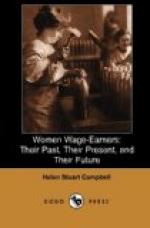Six divisions had been found essential to the thorough handling of the subject; and these divisions have formed the basis of all work since done in the same lines, whether in State bureaus or in that of the United States, soon to find mention here. It was under the direction of Colonel Carroll D. Wright that the Massachusetts Bureau did its careful and scientific work; and he represents the most valuable labor in this direction that the country has had, deserving to rank in this matter, as Tench Coxe still does in the manufacturing system, as the “Father” of the labor-bureau system.
The six divisions settled upon as essential to any general system of reports were as follows:—
1. Social Condition. 2. Occupations, Places in which Employed. 3. Hours of Labor, Time Lost, etc. 4. Physical and Sanitary Condition. 5. Economic Condition. 6. Moral Condition.
The Tenth Census of the United States gave the number of women employed in the city of Boston as 38,881, 20,000 of whom were in occupations other than domestic service. Each year, as we have already seen, had touched more and more nearly upon the facts bound up in their lives, but it had become necessary to determine with an accuracy that could not be brought in question precisely the facts given under the six headings. To the surprise of the special agents detailed for this work, who had anticipated disagreeables of every order, the girls themselves took the liveliest interest in the matter, answered questions freely, and gave every facility for the fullest searching into each phase involved. American girls were found to form but 22.3 per cent of the whole number of working-women in Massachusetts, of whom but 58.4 per cent had been born in that State.
The results reached in this report may be regarded as a summary, not only of conditions for Boston, but for all the large manufacturing towns of New England, later inquiry justifying this conclusion.
The average age of working-girls was found to be 24.81 years, and the average at which they began work, 16.81; the average time actually at work, 7.49 years, and the average number of occupations followed 178, the time spent in each being 4.43 years. Of the whole, 85 per cent were found to do their own housework and sewing, either wholly or in part.
But 22 per cent were allowed any vacation, and but 3.9 per cent received pay during that time, the average vacation being 1.87 weeks. A little over 26 per cent worked the full year without loss of time, while an average of 12.32 weeks was lost by 73 per cent. The average time worked by all during the year was 42.95 weeks. In personal service 26.5 per cent worked more than ten hours a day; in trade, 19.5 per cent were so employed, and in manufactures 5.6 per cent. In all occupations 8.9 per cent worked more than ten hours a day, and 8.6 per cent more than sixty hours a week.
In the matter of health 76.2 per cent of the whole number employed were in good health.




